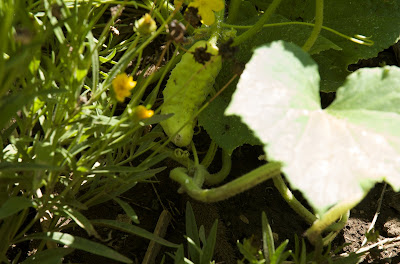I found a promising discovery on a melon plant (Delice de Table).
A nice melon forming under the canopy of leaves. I grew this variety because I liked the Seed Savers Exchange description:
French heirloom listed by Vilmorin in 1885. Translates as “Delight of the Table.” Ribbed fruits have sweet orange flesh and weigh about 1-2 pounds. Very hard-to-find, almost extinct. 85-90 days.
Also under the canopy of leaves, and about a half-gopher length away from the forming melon was a gopher hole.
Seems that gophers like to feed on the fruits of melons. Much to my dismay, another loss to those underground pests.

My permaculture training suggests I don't have too many gophers but too few enemies of gophers. Should I import gopher-snakes to reduce the population? The local cats are not doing their part, and birds of prey have little chance with all the cover my garden offers to gophers.
Too many heartaches from gophers eating my garlic, onions, potatoes, hollyhocks, and pea plants (to name only a few), led me to trapping.
I have kept count of the gophers I trapped. Nineteen gophers in as many months is what I consider an infestation. I still have a few gophers working the garden, but 19 is ridiculous.
In any garden some crop loss is expected—to birds or bugs—but last year gophers took more of my garlic crop than I got and they would have taken it all if I hadn't dug it up. They destroyed an entire fig tree by eating its roots all the way to the trunk, until the tree just wilted and flopped over. They have eaten the roots of mature hollyhocks, have eaten many plants worth of potato tubers, and taken down mature leeks just at their peak.
I observe their activity, and will trap when I take too many plant losses in an area. This melon still needed weeks on the vine to ripen, and it takes such a long time to even get fruit on some melon plants. In times like this it is difficult to not get discouraged.
Eliot Coleman, in his latest book
The Winter Harvest Handbook, writes about a crop-devestating problem he had with meadow voles, and how the only solution he found was trapping.
Eliot Coleman writes "Although I am a mild-mannered sort and show great kindness and respect to wild creatures in general, I admit to a strong aversion to voles in the winter greenhouse."
"I know from my records that one year I trapped over fifty voles in the vicinity of the greenhouses during August and September, and a neighbor's cat probably got almost that many. Come winter it didn't seem as if we had even made a dent."
Knowing that Eliot Coleman, the organic gardening and farming guru of our time, traps meadow voles made me feel less monstrous in my own trapping efforts.
I hope I am able to grow some of these melons to maturity so that I might taste such an old variety and also that I might participate in saving and sharing the seeds of an amost extinct food.

 Both plants provide delicious leaves to eat in the winter.
Both plants provide delicious leaves to eat in the winter.















































